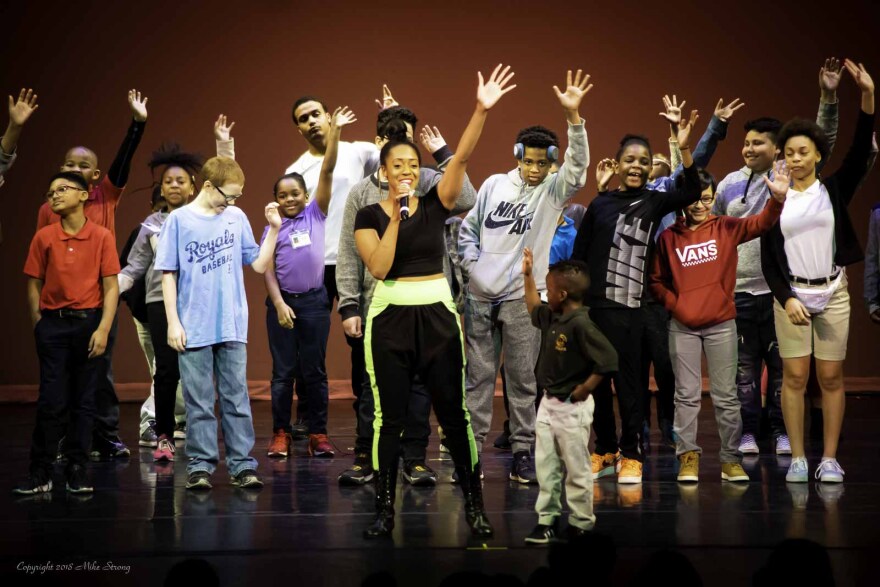Creating high quality art for kids is no easy task. As an audience, they’re pure in their responses: If the work engages them, they’ll roar in approval; if not, they’ll (at best) stare glaze-eyed or (at worst) rumble with disinterest as they turn their attention elsewhere.
The 800 middle- and high school students who whooped and chattered excitedly at the world premiere of a sophisticated new dance theater concept apparently approved of the Kansas City Friends of Alvin Ailey's performances at the Folly Theater on Wednesday and Thursday.
“I really wanted to create something that would be reflective of the students who would be seeing this, to have an opportunity to look at history, or ideas behind history, with a contemporary aspect,” said Tyrone Aiken, the company’s chief artistic officer.
Most years, Kansas City Friends of Alvin Ailey brings in dancers from New York City’s Ailey II company for these school performances, but Aiken decided to create something new in honor of the Kansas City company’s 35th anniversary. The result was “Gone Before,” exploring themes of migration, displacement and home.
At first, Aiken thought of migration in regard to the experience of African Americans, people first brought to the Americas through enslavement who then moved from the South to the North.
“But as I started to look, the idea of migration and displacement can be very broad,” he said. “For me, it became this universal idea: the idea that we are always living on a planet where there is — somewhere, someplace — displacement happening.”

Migration and immigrant rights is a coal-hot topic right now, but it’s been a consistent factor for all of human history: hunters and shepherds followed herds, refugees fled violence, enslaved people were transported against their will, famine and crushed economies forced entire communities to seek new opportunities.
Aiken reflected this history by enlisting a variety of artists, combining music and dance (naturally) but also a poet and a cartoonist.
Tap dancer Taylor Edwards started the show. With sounds made by the body, this form of dance honored those early Africans brought to America, whose traditions of drumming were forbidden so they found ways of expression through their hands and feet and voices.
From there, the arc of the piece followed the common path in migration stories: loss, displacement, struggle, heartbreak, journey, arrival and celebration.

Throughout, Aiken used both modern dance and African dance, set against a soundscape from composers Isaiah Yurking and Desmond Mason, beats by drummer C. Jaisson Taylor and soulful spirituals by singer Hope Mcintosh.
The students responded most strongly to Mcintosh, greeting her renditions of “Motherless Child” and “Battle Hymn of the Republic” with uproarious applause.
And they were stunned by spoken-word artist Sheri “Purpose” Hall’s definitive delivery of her poem “Heart and Home,” which contends with longing and heartbreak. As dancer Kennedy Banks moved across the stage in response to her strong imagery, Hall proclaimed the heart to be a “locked out thing, roaming a strange land.”
The students had likely read up on what they were seeing because the company created a teachers’ guide to help prepare them for the performance and facilitate discussion afterwards. That included images by cartoonist Arie Monroe, demonstrating another method of storytelling and representation.

During the powerful “We All The Same,” modern dancers each took a solo, responding to stories from the living memory of people who had been displaced: Jews escaping the Holocaust, Palestinians removed from Israel, Rohingya persecuted in Myanmar and others.
To balance the seriousness of the subject matter, Aiken inserted what he called “disturbances”: hip hop dance breaks that lightened the mood but also underscored one of the overarching causes of migration — money.
When the subject matter grew heavy, Cardi B got turned up. Students let out hoots of recognition at the first chord. Not only where they were allowed to get up and dance, they were encouraged to get out their phones and take pictures. Most choose that option, remaining in their seats.
After the last break out, though, the hip hop artists invited volunteers on stage to learn a short routine. The students who did so relished the spotlight and the hollers from their classmates.
The work ended with victorious statements from Hall — “I am anywhere and everywhere I want to be” and “I am enough and so much more,” emphasized by expressive bursts from the five dancers — which seemed to leave the students in a reflective mood.
“I don’t really make things for young people, per say,” said Aiken. “I make things that I think young people can access. Without talking down … I want to make it so they can understand.”
He was thinking about the future.
“It’s something that’s in layers, so there’s an understanding you may get, and when you are older you may understand a little bit more.”
KCUR contributor Libby Hanssen writes the culture blog Proust Eats A Sandwich. Follow her on Twitter, @libbyhanssen.
Copyright 2021 KCUR 89.3. To see more, visit KCUR 89.3. 9(MDA3OTgyNDI4MDEzMTM0MjQzMTZlNDI0Mg004))


